| Official Name: | Republic of Panama |
| Official Language: | Spanish |
| Area: | 75,417 km2 (29,119 sq mi) |
| Population: | 4,177,000 |
| Time Zone: | UTC−5 |
| Capital City: | Panama City |
| Elevation (Panama City): | 2 m (7 ft) |
| Currency: | Balboa (PAB) & Dolar (USD) |
| Main Cities: | C. de Panamá, Santiago, Colón |
| Main Port: | Puerto de Balboa |
| Required visa for entry: | Nationals from Canada, EU countries, and the UK and others DO NOT require visas. Click here for more information concerning visa requirements. |
| Required vaccination for entry: | Yellow fever. Travelers from Brazil and endemic countries must vaccinate 10 days before entering Panama. (Review epidemiological alerts by clicking here). |
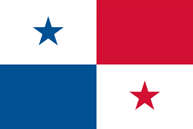
Main Risks:
Theft, robbery, kidnapping, extortion, rape, drug and human trafficking, fraud, vehicle assault.
Executive Summary
Panama features medium risks. Security risks increase considerably in remote areas beyond the main cities, as well as in impoverished neighborhoods of the capital. Avoid all travel to the Darien Gap. Furthermore, avoid non-essential travel to the city of Colon due to heightened criminal activity. For business trips, we recommend procuring secure transportation services. For high-profile trips, we further recommend hiring executive protection services.
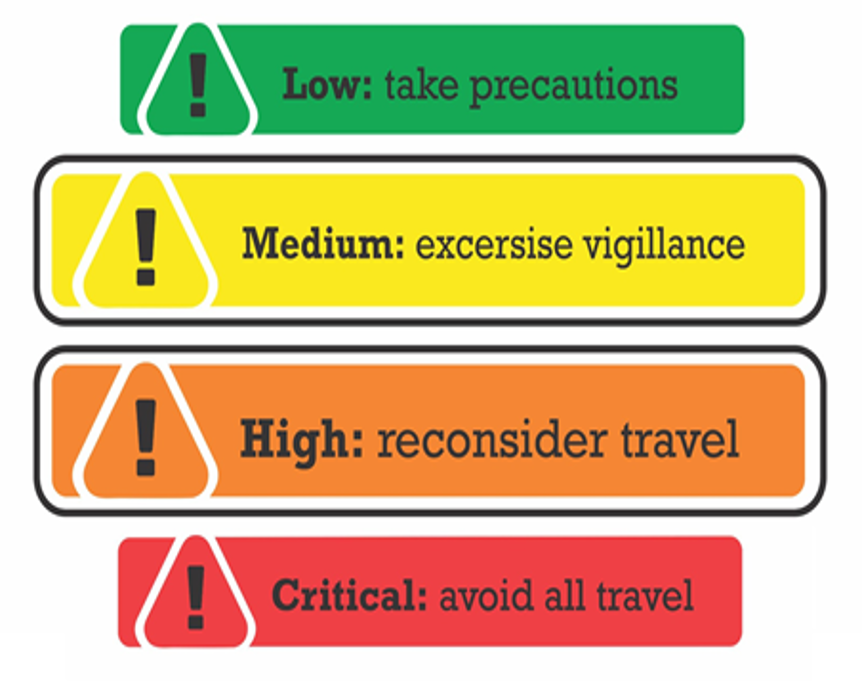
General Risk Level: MEDIUM and HIGH.
The risk generally remains stable throughout the country with the notable exception of the Darien Gap. In general, visitors should avoid non-essential travel through high-risk areas, including remote and jungle areas, and impoverished neighborhoods in cities with little police control. Although it is not necessary to study a security plan before traveling to the capital, it is convenient to review security considerations under professional supervision before traveling to other sites in Panama.
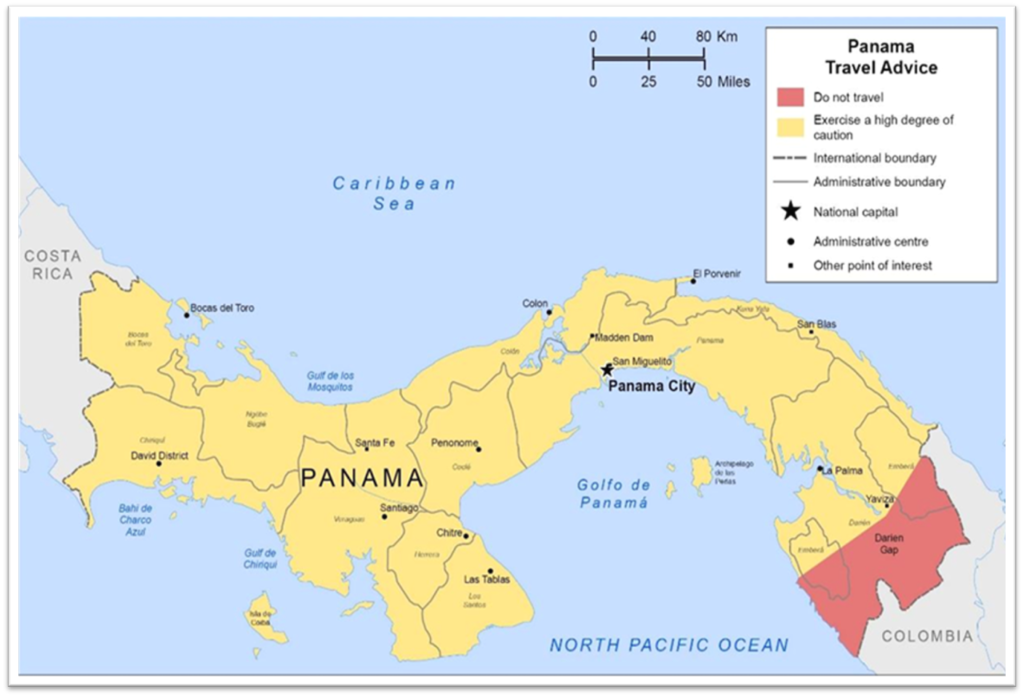
Crime and Security
The main threat to those visiting Panama stems from opportunistic low and medium level crime. Although violent incidents are more likely to take place in impoverished neighborhoods and remote areas, crime is also recurrent in relatively safe districts. Many criminals in the city often operate on motorbikes to assault vehicles at a standstill and distracted pedestrians. Although Panama is seen as safer than other Central American countries, the US Embassy warns citizens that the shootings and armed assaults remain a problem throughout the country.
Non-essential travel to the city of Colon should be avoided, especially without secure transportation services. Armed gangs operate in the city and there is heightened criminal activity. Moreover, travelers should refrain from venturing into jungle and/or sparsely populated areas. This is especially the case concerning the Dorian Gap. The region is virtually anarchic, lacks public infrastructure, and armed militant groups operate in the area.
Finally, please bear in mind that Panama has a hurricane and tropical storm season between June and November. Adverse weather can lead to security risks, especially in seaside areas, and may lead to travel disruptions and deficiencies in basic services.
Security in Panama City
Criminal episodes can be witnessed across the city. That said, as a rule of thumb, the risks stemming from crime increase in impoverished and peripheral areas, including the neighboring city of San Miguelito. Although there are no significant risks in the Casco Viejo and Panama Viejo (Old Town & Old Panama) tourist sites, it is necessary to stay alert and exercise vigilance. The safest areas to lodge and carry out business and transactions are the commercial districts running along the shoreline, namely Cinta Costera, Costa del Este, Punta Pacífica, and the Obarrio neighborhood. These areas concentrate the upper-middle classes in the country. They are perceptibly safer due to higher police presence and protection from private security elements. The main hotels can also be found in these areas. It is also feasible to stay in exclusive residential areas removed from central parts of the city, especially Clayton and the vicinity of the Santa María Golf Club.
For security reasons, do not travel to high-risk areas, including the city of San Miguelito, without procuring secure transportation services. In any case, to mitigate the risk posed by crime, we advise avoiding non-essential through the city during dark hours.
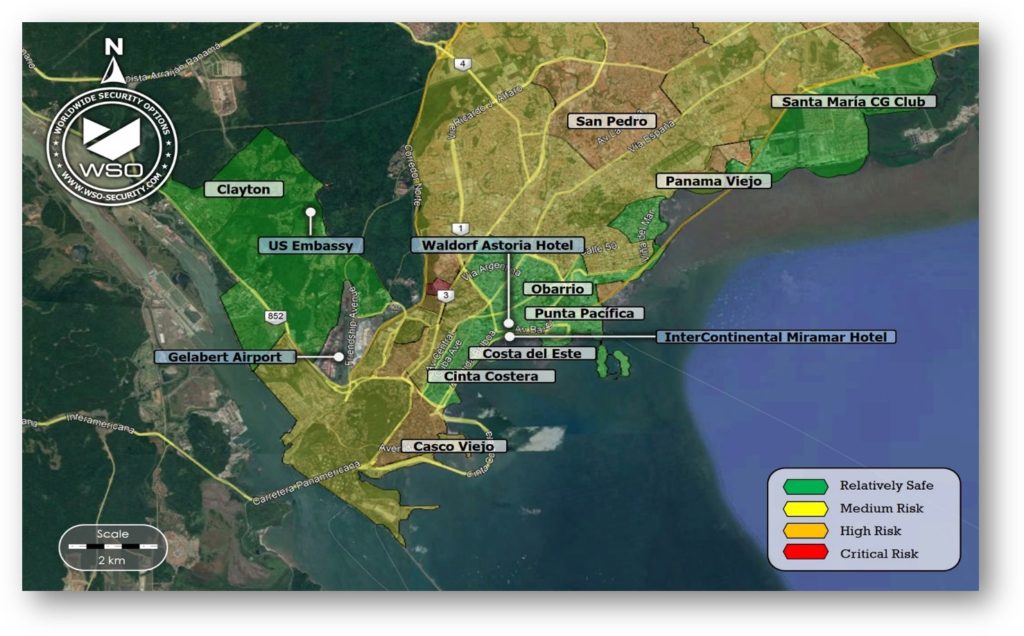
Three commercial airports are servicing Panama City. The International Tocumen Airport (PTY) is one of the largest hubs in Latin America in terms of international routes. It is about 30 minutes away from Cinta Costera depending on traffic. In turn, the Panama Pacífico International Airport is smaller and serves regional routes. Finally, the Albrook Marcos A. Gelabert Airport is closer to the city, only about 10 minutes away from the commercial districts. It serves domestic routes for the most part.
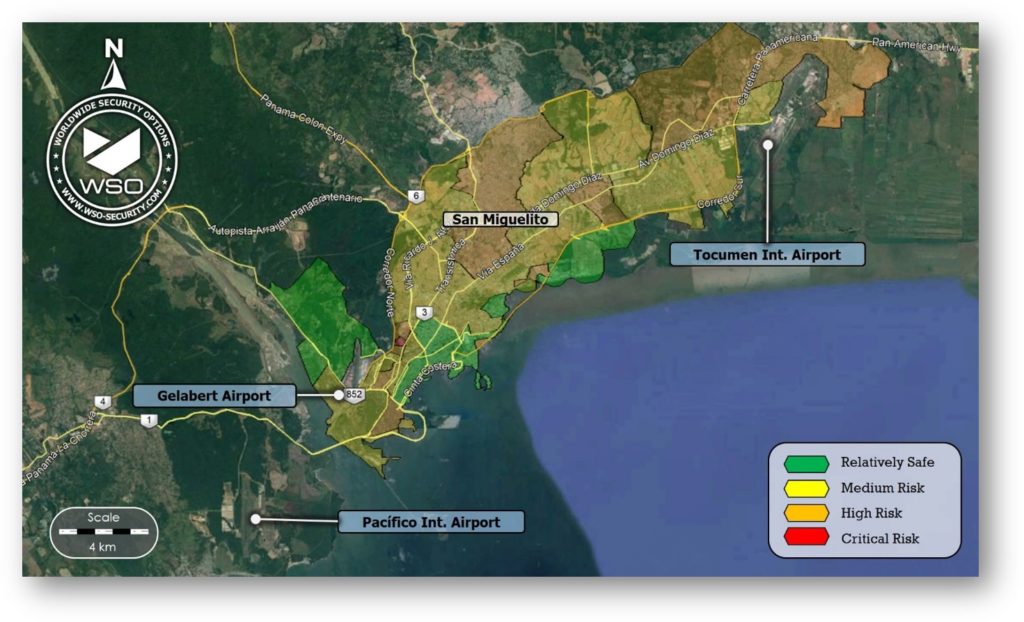
Transportation
For security reasons, in Panama, public transportation should be avoided. For business and high-profile trips, we advise procuring reputable private transportation services. For the latter, we further advise hiring executive protection services. Generally speaking, it is possible to use smartphone-based ride-sharing apps. Regular taxis can be used provided they are recommended by the prominent hotels, preferably booked in advance. That said, please be advised that some regular taxi drivers might attempt to take advantage of foreign passengers to inflate the price of the trip.
Although land routes are generally in good condition, traveling through sparsely populated areas with adverse topography entails security risks, especially during the night or under conditions of poor visibility. Therefore, if traveling by land, do not deviate from primary thoroughfares or highways. It is best to avoid secondary routes removed from central localities and which remain in poorer circumstances. If travel to Panama involves visiting locations outside the capital city, whether for business or tourism, make sure to plan the route in advance under the supervision of local security professionals. Educated assessments should enable the security contractor to determine the safest route and avoid unilluminated or otherwise dangerous paths.
Health and Sanitary Conditions
Panama is vulnerable to tropical storms. Travelers should pay attention to meteorological conditions and avoid touristic trips during the hurricane and rainy season.
Travelers coming from Brazil and yellow fever endemic countries (review epidemiologic alerts clicking here) should present a vaccination certificate upon entry. In any case, it is also recommended vaccinating against tetanus, hepatitis A and B, and typhoid. Taking into account the tropical weather, it is very important to wear protection against bugs and avoid leaving body areas uncovered to mitigate the risk of suffering insect and mosquito-borne diseases such as Dengue, Chagas, and the Zika virus. These precautions should be followed at all times while entering remote and jungle areas. The quality of tap water in Panama City and the main urban areas is relatively high but this is not necessarily the case in remote and rural areas that lack adequate sanitary infrastructure. It is therefore recommended to drink sealed bottled water while visiting or staying in such areas.
It is not advised to travel without international health insurance covering emergency medical evacuation to the country of origin.
Take essential health precautions to mitigate the risk of contracting diseases or viruses. Carry masks in crowded places such as airports and maintain rules of social distance and avoid contact with surfaces of common use in public places. Always carry hand sanitizer.
Tactical Recommendations
Exercise vigilance and situational awareness throughout the trip to Panama, especially in urban areas vulnerable to low and medium-level criminal activity. In Panama City avoid venturing into high and critical-risk areas.
We recommend procuring private transportation services for business and high-profile trips, and itineraries involving travel to the countryside. For high-profile trips, we further recommend hiring executive protection services. For security reasons, do not use public transportation. If required, use taxis vetted by the main hotels and ride-sharing apps.
Avoid carrying large sums of cash or valuables during the trip. We advise against wearing or carrying items in public that may give the impression of economic affluence and which could attract unwanted attention from criminals.
Avoid traveling through the country, outside Panama City, in sport or luxurious cars which could attract unwanted attention from criminals.
Do not resist armed robbery attempts. We recommend to always carry a few 50 USD bills for duress cases, specifically to appease criminals looking for easy money.
For security reasons, minimize travel during night hours, even in Panama City.
We recommend lodging in reputable establishments and hotels with private security. In Panama City, it is best to stay in Cinta Costera, Costa del Este, Punta Pacífica, and Obarrio.
If travel by route through the countryside is required, avoid all detours, especially while traveling through sparsely populated rural or jungle zones. If possible, plan routes and stopovers ahead with the support of a local security contractor.
Avoid the vicinity of every kind of political demonstration or rally in urban areas. Peaceful protests can be infiltrated by violent elements.
Take all necessary precautions to mitigate the risk posed by insect and mosquito-borne diseases. When visiting remote locations drink sealed bottles if the quality of tap water is questionable.
Emergency Contacts
Police: 104
Ambulance: 911
Fire: 103
WSO Global Command Center: +1 956 467 4858 / gcc@wso-security.com
Security advice and assistance over WhatsApp: +593 99 461 1128 / +521 81 1511 3166







